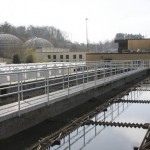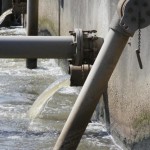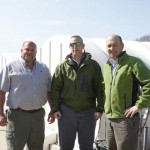- Seeking clarity: Setting ponds allow sludge to be separated in a clarification step after biological treatment using hungry microbes.
- You are what you excrete: Waste water arrives for treatment following a screening step to remove coarse debris.
- Don’t panic, it’s organic: MSD’s General Manager, Tom Hartye, gives a geographic overview of their 960-mile-long network of sewer lines (top). (Bottom) A press extrudes the last drop of water from sewer sludge before it’s incinerated. Photos by Jonathan Welch
- Our sultans of sewage: MSD’s Ken Stines, John Kiviniemi and Peter Weed make sure the system does its job 24/7.
Most of us don’t give much thought to what happens once we flush the toilet — and thanks to the Metropolitan Sewerage District, we don’t have to.
But without MSD, we’d be wading in waste: Before the treatment plant on Riverside Drive in Woodfin came online in 1967, untreated wastewater was discharged directly into local waterways. Large, sudden discharges can be serious: On April 6, a massive sewage spill in Gatlinburg, Tenn., killed two workers and sent millions of gallons of raw sewage into the Little Pigeon River. Such spills typically result in fish kills and other environmental damage and can also have negative health impacts.
Established under state law in 1962, MSD is charged with collecting and treating wastewater in Asheville and environs. It’s a tall order: The agency’s service area covers about 180 square miles, with 960 miles of sewer lines linking Asheville, Biltmore Forest, Black Mountain, Montreat, Weaverville, Woodfin and unincorporated areas. Every day, the utility treats an average of 16 million gallons of wastewater, relying on millions of microbes to do what they do best: consume organic waste.
From toilet to turbine
“Unfortunately, a lot of folks use their toilet as a trash can [for] everything from ballpoint pens to prophylactics,” says John Kiviniemi, MSD’s director of water reclamation. To avoid clogging, he explains, “The first step is to get that material out and take it to the landfill.”
An aerated chamber separates inorganic solids; then comes the painstaking process of removing accumulated grease. “It’s very labor-intensive,” Kiviniemi reports. “We’re really trying to educate homeowners about not putting grease down the drain.”
Biological treatment relies on 152 huge, rotating drums, whose grooved surfaces host hungry microbes in a living layer of slime, all steeped in a watery mix providing everything a one-celled organism could want. Amazingly, the odor around the drums is minimal; a foul smell means the system isn’t working properly. Installed in the 1980s, this aerobic process produces no methane (a potent greenhouse gas that contributes to global warming).
The next stage is clarification: holding ponds allow sludge to settle out, so it can be pressed until nearly dry and then incinerated. This produces air emissions, including nitrous oxides, sulphur dioxide, toxic metals and other pollutants, which are monitored by the WNC Regional Air Quality Agency. The treated wastewater is then disinfected (using chlorine) and tested for a long list of pollutants — way more than what they’re required to monitor, says Kiviniemi.
As the water exits the plant, MSD harvests kinetic energy from the river via its hydroelectric installation on the French Broad River. “We could make even more power,” he adds, “but we’re required to maintain the water level.”
Pipe gripes
Perhaps the biggest single challenge is getting sewage to the treatment plant without losing any en route. In 1990, MSD assumed ownership of a hodgepodge of smaller local collection systems, many between 50 and 100 years old and in dire need of replacement. Since then, the utility has undertaken an aggressive program to correct the inherited problems. Between 1990 and 2009, MSD spent more than $254 million on system updates (including replacing more than 746,000 linear feet of pipe). But much work remains: Replacing roughly 1 percent of the lines per year is expected to cost more than $275 million over the next two decades.
Preventive maintenance is equally vital: Using high-pressure equipment, MSD cleaned nearly 1 million linear feet of sewer lines in 2009 alone. The utility’s acclaimed pipe-rating program inserts video cameras into aged sewer lines to evaluate their condition, helping prioritize projects.
Even so, the system overflowed 32 times last year (down considerably from the 288 releases in 2000). MSD must notify the public of such releases within 48 hours; the agency says the environmental impacts are minimal and are cleaned up according to state standards. Katie Hicks of Clean Water for North Carolina agrees, saying, “MSD does a pretty good job — better than many other treatment facilities in the state.”
These accidental discharges typically come during big storms. “The lines get so much [stormwater] coming in, they can’t handle any more. [If] the pipes aren’t large enough to handle that much flow … it’s gonna come out a manhole cover,” System Services Coordinator Ken Stines explains.
But blockages can also cause spills, and “If you have a spill in dry weather conditions, it’s all sewage coming out, ” he notes. “We’re really putting a lot of money into keeping these from happening.”
There are other hazards too. “We issue permits on 22 industries to ensure they aren’t dumping bad things on us,” notes General Manager Tom Hartye. They include Milkco in West Asheville and Shakespeare Conductive Fibers in Enka.
All together now
Laying sewer lines requires incredible precision. “Sewer is the most difficult utility to construct,” says Capital Improvement Director Ed Bradford.
“We’re very fortunate, with the topography in the mountains, to be able to do everything by gravity,” Chief Inspector Mike Schraven points out. “The furthest reach of our system is at Ridgecrest in Black Mountain. The effluent from Ridgecrest comes to the treatment facility by gravity — never touching a pump.” The key to keeping it all moving, he notes, is gradient. In one current project, Schraven explains, “We’re at two-tenths of a percent — meaning there’s only that much change in 100 lineal feet of pipe. And it’s done for miles.”
“It’s very expensive work,” he continues. “We fixed the interceptor from Ross Creek all the way down to the Swannanoa River, accommodating all that commercial development along the way. But in the end, it protects Ross Creek,” which the state considers an impaired stream.
Clearly, MSD sees itself as a major environmental steward. “I live downstream of the treatment plant,” Stines reveals. “I want us to do everything we can to protect the rivers … and recreation. Everybody here at MSD does.”
Kiviniemi concurs. “This treatment plant is publicly owned — it belongs to the ratepayers. The wastewater that we’re treating, it’s not an us-and-them thing: It’s us. We’re all in this together.”
— Direct your local environmental news to Susan Andrew (251-1333, ext. 153, or sandrew@mountainx.com).








April 24 2016 7:30 pm took short walk along French Broad river park about 2 miles downstream of sewage plant Woodfin area and everything seemed to smell like open sewer pit.
Wondering what is going wrong. Is sewage plant overloaded?
Seems awful.